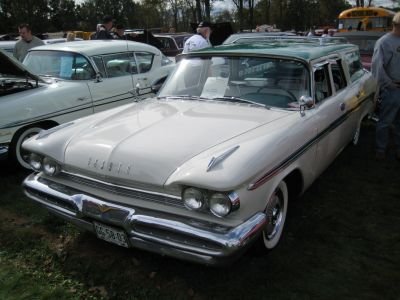 1957 DeSoto Firesweep I Station Wagon Dimensions, Size & Specs
1957 DeSoto Firesweep I Station Wagon Dimensions, Size & Specs
Measurements of the 1957 DeSoto Firesweep I Station Wagon, engineered for optimal performance and comfort
| Dimensions | |
|---|---|
| Length: | 5522 mm217.4 in18.1 ft |
| Width: | 1986 mm78.2 in6.5 ft |
| Height: | 1440 mm56.7 in4.7 ft |
| Ground Clearance: | 137 mm5.4 in0.4 ft |
The DeSoto Firesweep I Station Wagon, produced between 1956 and 1957, stands as a striking example of mid-1950s American automotive design tailored to families and utility. Featuring a length of 5522 mm (217.3 inches), a width of 1986 mm (78.2 inches), and a relatively low height of 1440 mm (56.7 inches), the Firesweep I Station Wagon balances spacious interior room with a stable road presence. This vehicle embodies the full-size segment characteristic of the era, offering ample cargo space and passenger comfort typical of station wagons from the period.
Ground clearance for the Firesweep I stands at 137 mm (5.4 inches), providing sufficient clearance for suburban and light road conditions common in the 1950s. The station wagon's size reflects the trend of the decade where families increasingly sought versatile vehicles capable of transporting both passengers and gear. Despite its large exterior dimensions, the design maintains a streamlined and elegant profile, which was a hallmark of DeSoto's styling philosophy.
As a classic car today, the 1957 DeSoto Firesweep I Station Wagon represents both an automotive collectible and a practical example for those interested in vintage station wagons. When compared to other vehicles of its time, its considerable length and width place it firmly in the upper-middle size range for station wagons, making it a suitable point of comparison for enthusiasts and historians considering the evolution of car size in the post-war period.
Discover the standout features that make the 1957 DeSoto Firesweep I Station Wagon a leader in its class
Have a question? Please check our knowledgebase first.
The 1957 DeSoto Firesweep I Station Wagon measures 5522 mm (217.3 inches) in length, 1986 mm (78.2 inches) in width, and 1440 mm (56.7 inches) in height. These dimensions place it firmly within the mid-to-large size station wagon category of its era, offering a substantial presence on the road while maintaining a relatively low profile compared to some of its contemporaries.
The 1957 DeSoto Firesweep I Station Wagon has a ground clearance of 137 mm (5.4 inches). This moderate ride height strikes a balance between stability and the ability to handle less-than-perfect road surfaces, typical of mid-20th-century American station wagons. The clearance is sufficient to navigate typical urban and suburban obstacles but is not designed for off-road use.
With a width of 1986 mm (78.2 inches), the Firesweep I Station Wagon is relatively wide even by modern standards. Many of today's station wagons have widths in the range of 1800 mm to 1900 mm. This width provides a spacious cabin and helps accommodate three-abreast seating and generous interior space, making it comfortable for families and cargo.
Standard garage sizes vary, but a common single-car garage is around 3 meters (about 10 feet) wide and 6 meters (about 20 feet) deep. The Firesweep I Station Wagon’s length of 5522 mm (17.3 feet) and width of 1986 mm (6.5 feet) means it will generally fit lengthwise but may occupy much of the garage width, leaving limited space on the sides. Owners should measure their garage dimensions for optimal fit, especially considering door-opening space requirements.
A height of 1440 mm (56.7 inches) is relatively low compared to modern SUVs and some station wagons but typical for 1950s wagons. This height usually provides adequate headroom for passengers while maintaining a sleek roofline. It contributes to easier entry and exit compared to taller vehicles, though interior headroom may be more limited for taller individuals compared to today's more spacious designs.
While specific weight figures for the Firesweep I Station Wagon aren't provided here, vehicles of this size and era typically weighed between 1700 to 2000 kilograms (3750 to 4400 pounds). This heavier mass contributes to a sturdy ride feel and solid road presence but usually results in lower fuel efficiency compared to modern lighter cars. The weight also influences handling, often providing stable but less agile dynamics compared to smaller, lighter vehicles.
The 1957 Firesweep I Station Wagon was one of the initial model years for the Firesweep line, which replaced earlier Desoto models but did not have a direct equivalent predecessor station wagon under the Firesweep name before 1956. Compared to earlier Desoto station wagons, the Firesweep I typically featured more modern styling, slightly larger or more optimized dimensions for interior space and road presence, reflecting the evolving American station wagon trend of the mid-1950s.
In comparison to contemporaries like the 1957 Chevrolet Nomad or Ford Country Squire, the DeSoto Firesweep I Station Wagon is similarly sized, with a length around 5.5 meters (217 inches) and width near 2 meters (78 inches). This puts it on the larger end of the station wagon spectrum for its time, offering competitive interior space and cargo capacity. However, styling and ride quality differences also played a big role in buyer preference beyond just size.
The 1957 DeSoto Firesweep I Station Wagon is notable for its stylish, sleek 1950s design combined with practical station wagon utility. Produced during 1956-1957, it embodied the transition in American automotive styling toward longer, lower, and wider cars. It featured spacious interiors suited for family use and reflected the post-war boom in American car ownership. Although DeSoto as a brand was discontinued shortly after, the Firesweep remains a collector's piece representing mid-century automotive design and family transportation.
The Firesweep I Station Wagon offers a distinctive combination of classic mid-century American styling, spacious and practical station wagon design, and relatively uncommon brand heritage. DeSoto, a Chrysler division, ceased operations in 1961, making its models increasingly rare and sought after by collectors. This specific 1957 station wagon is valued for its smooth, low-slung aesthetics, solid build, and nostalgic appeal that captures the essence of 1950s American motoring culture.
Discover similar sized cars.

| Production: | 1958-1959 |
|---|---|
| Model Year: | 1959 |
| Length: | 5489 mm216.1 in |
| Width: | 1999 mm78.7 in |
| Height: | 1450 mm57.1 in |
